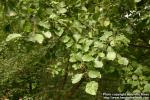Alnus.—Tag Alder.
The recent bark of the Alnus serrulata, Aiton. (Alnus rubra).
Nat. Ord.—Betulaceae.
COMMON NAMES: Tag alder, Red alder, Black alder, Smooth alder, Common alder.
Botanical Source and History.—This shrub grows plentifully throughout the United States from Southern New England to the western border of the Great Lakes and. southward. It occurs as clumps or thickets, along the borders of streams, rivers, ponds, and in swamps, attaining a height of from 6 to 15 feet. The stems are straight and the leaves smooth, somewhat coriaceous, obtuse, doubly serrate, round or blunt at the apex, and are accompanied by elliptical, obtuse stipules. Its flowers appear in March and April, before the leaves have expanded, and are of a reddish-green color. The pistillate flowers are borne in an erect, and the staminate, in a drooping, catkin. The fruit, which is ovate, often persists throughout the winter and gives rise to the name "tag alder" The bark is brownish-gray when fresh, and has an astringent, bitterish taste.
Chemical Composition.—The bark contains tannin, oils, and resin. The first may be precipitated with gelatin. A lesser quantity is found in the leaves. Alnus is chemically antagonized by the mineral acids, alkalies, ferric salts, salts of lead and silver, and gelatin.
Action, Medical Uses, and Dosage.—To the taste tag alder is bitter and astringent. It powerfully increases retrograde metamorphosis and exerts a direct tonic action upon mucous surfaces, aiding digestion and assimilation. It is a true catalytic and a positive anti-putrefactive agent. Locally applied, the decoction stains the skin. The drug stimulates the gastric mucous membrane and causes an increased flow of gastric juice. Applied to the mammae, the leaves are said to decrease the lacteal secretion. It is alterative, emetic, and astringent.
This much neglected, but very important, remedy is a valuable agent in scrofulosis, especially in those cases marked by glandular enlargements and suppuration. Prof. Scudder speaks of it as one of the most valuable of our indigenous remedies, and points to its use in "superficial diseases of the skin and mucous membranes, taking the form of eczema or pustular eruption." Administered internally and applied locally in these conditions, we may expect from alnus the best of results. Impetigo, prurigo, herpes, and scorbutus, are diseases in which alnus will be of great utility. In scurfy tetter of the scalp, in children, it is of much value. The happiest results are obtained from its use in successive crops of boils. It is a good agent in passive hemorrhages, particularly in hematuria, for which a decoction of the cones has also been used, and it is favorably mentioned for purpura hemorrhagica. In marasmus of children, it is a much praised remedy. Combined with rumex crispus, and used locally and internally, it is a good drug in nursing sore mouth of mothers. Alnus is an important drug in indigestion and dyspepsia, when resulting from deficient secretion of gastric juice and debility of the muscular coat of the stomach. It may be associated with specific nux vomica. In diarrhoea, caused by or attended with deficiency of the gastric secretion, it serves an excellent purpose. It has been used with good results as an injection for leucorrhoea, and the leaves may "scatter" indurations of the mammary glands during the nursing period. Ɣ Dr. A. D. Ayer reports many cases of periodical hyperaesthetic rhinitis (hay fever) cured by alnus. He recommends a distillate prepared after the manner of distillate of hamamelis. The distillate is first used with an equal bulk of water and snuffed up the nostrils 5 or 6 times daily. It may be increased to full strength in a day or two. If desirous, it may be applied by atomization. At night the nose is smeared with the distillate combined with petrolatum. At the same time give internally: Rx Distillate of alnus, gtt. xv to xxx, in a little water, 1 hour before or after meals. Dr. Ayer also recommends this preparation in the acute stage of gonorrhoea, and as an antidote to rhus poisoning. The remedy is most effectual in infusion (fresh alnus bark, ℥j, aqua Oj); dose, a wine-glassful. Specific alnus, 1 to 20 drops.
Specific Indications and Uses.—The specific use of this remedy is to improve nutrition and increase waste. It is of particular value in scrofula, with feeble vitality, and chronic skin diseases exhibiting scaly or pustular eruptions.
 Related Species.—Alnus glutinosa, Gaertner. (Betula Alnus, Linné). Europe. A tree about 30 feet high, the bark of which contains tannin, and is employed for the same purposes as the Alnus serrulata. Its bark is probably gathered indiscriminately with that of the latter. The wood resists water, and has been much used for posts and piles, for wet situations, the wood thus becoming very hard and durable. It was formerly employed in making water-pipes, pump-trees and reservoir conduits; in sculpture, turnery and cabinet-making; for making wooden household utensils, wooden shoes and soles, etc. Europeans have uses the bark for tanning and dyeing, and a charcoal from its timber in preparing gunpowder (Hogg, Nat. Hist. of Veg. King).
Related Species.—Alnus glutinosa, Gaertner. (Betula Alnus, Linné). Europe. A tree about 30 feet high, the bark of which contains tannin, and is employed for the same purposes as the Alnus serrulata. Its bark is probably gathered indiscriminately with that of the latter. The wood resists water, and has been much used for posts and piles, for wet situations, the wood thus becoming very hard and durable. It was formerly employed in making water-pipes, pump-trees and reservoir conduits; in sculpture, turnery and cabinet-making; for making wooden household utensils, wooden shoes and soles, etc. Europeans have uses the bark for tanning and dyeing, and a charcoal from its timber in preparing gunpowder (Hogg, Nat. Hist. of Veg. King).
Alnus viridis, De Candolle. Mountain alder. North America, This species is a shrub 3 or 4 feet high, the bark of which is employed in dropsical complaints by a British-American tribe of Indians living in the vicinity of Hudson's Bay.

